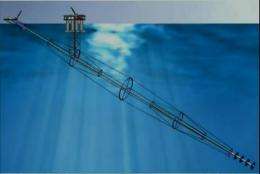January 18, 2010 report
Space cannon to shoot payloads into orbit (w/ Video)

(PhysOrg.com) -- A physicist has proposed using a 1.1 km (3,600 ft) cannon to deliver cargo into orbit, and says the cost would be around $250 per pound, a massive saving on the $5,000 per pound ($11,000 per kg) it currently costs to make deliveries using a rocket.
John Hunter, from the company Quicklaunch, which was set up by himself and two other scientists, bases its plans on previous work they carried out at the Lawrence Livermore National Laboratory in California. In 1992 Hunter and his colleagues fired a 130 m (425 ft) cannon built to test launch hypersonic engines. Its piston, driven by methane, compressed hydrogen gas that expanded up the barrel of the over-sized gun to shoot the projectile.
The Quicklaunch design has replaced the methane piston with a combustion system burning natural gas in a heat exchanger inside a chamber of hydrogen gas. The combustion system heats the hydrogen to 1,430˚C (2,600˚F), which increases the gas pressure by 500%. An operator then opens a valve to allow the hot, pressurized hydrogen into the 1100-meter-long barrel of the gun, where it instantly expands, shooting the projectile out and into space. As soon as the payload has left, an iris at the end of the barrel closes to capture the hydrogen for re-use. Once the projectile is launched, a small rocket engine then boosts the payload into a low-Earth orbit.
Hunter calculates the pressure would be sufficient to launch a 450 kg payload at six kilometers per second (13,000 mph). The process would produce 5,000 Gs, and so would only be suitable for rugged payloads such as strengthened satellites and rocket fuel. Hunter said the system could not be used as a people-launcher because a person shot out of the cannon "would probably get compressed to half their size," causing instant death.
Hunter said the heat generated would be short-lived, with the projectile clearing the atmosphere in under 100 seconds. He also said the projectiles may need to be designed so that outer layers could burn off.
Hunter's proposal is to operate the "Quicklauncher" from the ocean near the equator, where the Earth's faster rotation will help launch payloads into space. The cannon would float, with 490 m (1,600 ft) of it below the surface, where it would be stabilized by ballast. Operators would be able to swivel it as required to deliver the payload into different orbits.
Hunter plans to test a 3 meter prototype in a water tank in February, and a full-size cannon could be built within seven years, if Quicklaunch can raise the required $500 million. While this is a sizeable upfront cost, the potential savings in the long term are substantial, because the cannon is reusable. Its use would significantly reduce the cost of keeping the International Space Station in orbit.
The proposal was outlined in October in Boston, U.S., at the Space Investment Summit.
More information: -- Space Investment Summit: spaceinvestmentsummit.com/
© 2010 PhysOrg.com




















